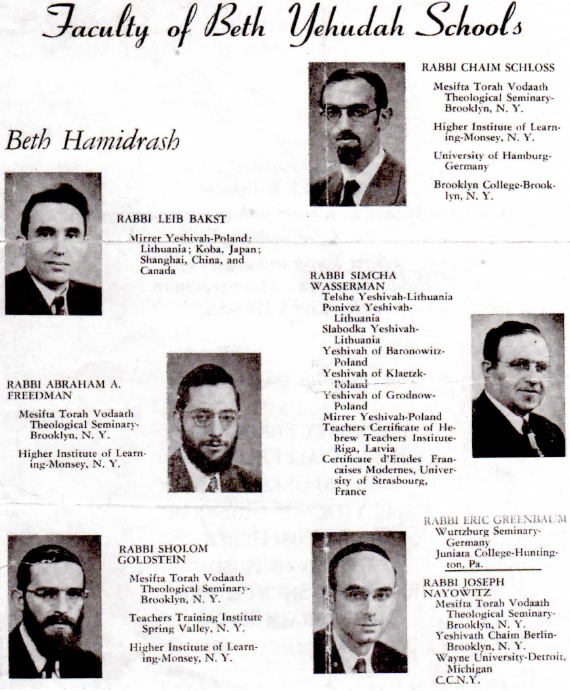In Rabbi Freedman’s Own Words
“We Are A Historical Society”
A few years ago America celebrated its centennial. It was 200 years since 1776. Every American has a quite accurate picture of events –Washington, Jefferson, Lincoln, etc. If we go back a few hundred years more to 1492, everything is also quite clear–Columbus–we know all about him–his ship and his sailors.
Let us go back a few more hundred years to the 10th century, the 9th century. Things start becoming unclear. Who exactly were the Saxons? The Francs? The Gauls? Who are the Indo Europeans? It’s a long distance from Europe to India.
Go back to around the year 70, the first century of the Common Era, things are a little bit clearer, because Roman and Greek historians made a strong effort to record that period.
Go back another 500 years, everything becomes clouded and unclear again. Go back a little further–it’s a maze consisting of ages! Bronze age! Stone age! A history that is more guesswork than history.
Compare Jewish History! If there are Kohanim in the auditorium tonight they know exactly who their ancestor was over 3000 years ago–Aaron the Kohain.
Is there a Levi in the house?–He comes from the tribe of Levi.
That’s in this auditorium, in this house. Go to a different house, any other house, even to the House of Representatives! To Congress! Find one non-Jew who can trace his ancestors 3,000 years ago. Our most distinguished people, our Presidents, the most prominent citizens, scientists, poets, cannot trace their ancestry–they cannot say about themselves, that which a little Jewish boy can say about himself.
Everybody is aware that the Sphinxes and pyramids were supposed to be “documents,” so to speak, of History. They were to tell the story and biography of Hexos Kings. Whole civilizations were harnessed as slaves, for decades, to build pyramids. Today we hardly know the identity of the Mummies, of the Kings interred there. The Mummies are as mum as their name mummy. The Sphinxes are mute as they appear.
If some of those mummies would be resurrected, would come alive again, they would drop dead in disappointment. “What! Nobody heard of me, King Tut the 4th? Why people quivered at my name!”
There was a time until the Rosetta Stone was discovered that the hieroglyphics was entirely lost. Imagine! For centuries no one knew anything of the messages contained in, and on the pyramids.
What is the secret of our ability to preserve the past? The answer is that we are historians. We love history! We even wear history. Rashi says that the four Tzitzes on the four corners are like the four cups of wine at the seder, reminding us of the four stages of redemption.
“I will take you out, I will save you; I will redeem you; I will take you to me as a people.” We have a Pesach Seder every day.
The slave people with their Matzah balls preserved the story better than their slave masters with their monuments. The seder on Pesach and the Kneidlach were more powerful than the giant buildings.
The Mezuzah on the door posts that Hashem passed over in Egypt makes the reminder of not a yearly ritual, but a daily one. Our homes become historical museums. Our first born children become historical exhibits.
A few weeks ago we celebrated Shavuos, the giving of the Torah.
We Americans celebrate the 4th of July. Historically, the weeks and days preceding the 4th were crucial. July 1st, 2nd, and 3rd were important days—but who knows of them, of the internal negotiations, the politics that took place – only perhaps a history scholar.
With us, comes Rosh Chodash Sivan, the beginning of the month, we make note in our daily davening by omitting tachanun. The countdown before the Torah was given is starting: six! five! four! Proposals back and forth to the women to the Bais Yaakov. To the men we make note of the special participation of the women. Three! the three days of boundary around Sinai has started. Two! One! the Ten Commandments are given.
Actually we started our count down 49 days before, with the counting of the Sefirah.
Soon we will have Sukkos. The historical society has a convention retreat for a week. The convention meets in a Sukkah.
The convention goes back to the desert. To our desert years, where we lived in huts under Hashem’s protection.
Before that—Yom Kippur. What happened at the first Yom Kippur? The Jewish people atoned for the golden calf that they made. They were forgiven!-Again history. Of course Rosh Hashana, the creation of the world is again history.
Isn’t Shabbos history? The world creation was finished. The two challahs are history—in memory of the double portion of Mannah in the desert. The challah cover in memory of the manner that the Mannah was given, sandwiched between two layers of dew, is also history.
Of course Pesach is pure history. We are a historical society—we are historians.
Our history is distinct in another point.
All history books end today, the morrow is hidden. Our modern day historians have all kinds of conjecture of the future, some are pessimistic, some are optimistic, some venture to talk of a utopian world, others of a cataclysm, man made or otherwise that will destroy the world. The pessimists talk of “Who will put out the last light.”
Yiddishkeit (Judaism) is as accurate about the future as about the past. The future, the Yemos Hamoshiach are as clear and vivid to us as our past. We are historians; yesterday, today and tomorrow. We are as sure of the unwritten last chapters of history as of those that have already transpired.

CLICK HERE TO RETURN TO INDEX